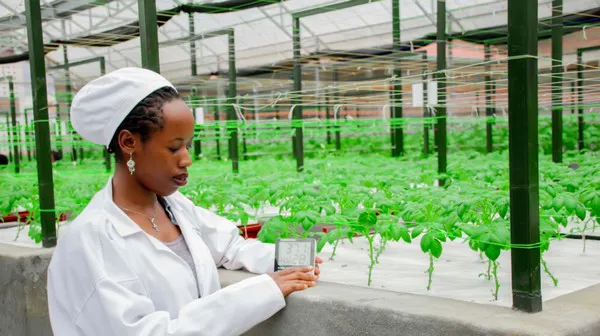Fresh from undertaking a six-month training in “Internet of Things” (IoTs) at the Catholic University of Rwanda (CUR) in the country’s Huye and Gisagara Districts, 24-year-old Clemence Uwamutarambirwa developed a mobile phone application that uses sensors to monitor soil quality and temperature and can automate irrigation.
UN Women Rwanda collaborates with the Catholic University of Rwanda under a joint youth programme funded by Multi-Partner Trust Fund (MPTF) and the Swedish International Development Cooperation Agency (SIDA) to support women and girls in creating job opportunities. Ms. Uwamutarambirwa was one of 25 trainees who benefited from the six-month IoTs training.

Ms. Uwamutarambirwa calls her app the Smart Potato Greenhouse Technology (SPGT).
Currently being used to detect levels of temperature and humidity of potatoes in greenhouses in Musanze District, southern province of Rwanda, the app is expected to be scaled up to other districts later in the year.
The invention is considered a significant agricultural solution to hunger. Its success will attract farmers in other parts of the country. About 69 per cent of Rwandan households engage in agriculture activities such as crop production or animal husbandry.
How it works
The SPGT app consists of two parts: The first part deals with interconnected sensors such as a moisture sensor to monitor the soil quality, a humidity sensor to monitor the humidity of potatoes, and a smart irrigation sensor to pump water to the greenhouse.
The second part deals with data transmission. It sends notifications, alerts, and other remote monitoring information to the mobile phones of greenhouse managers.
“The sensors capture pertinent data and send notifications and alerts to greenhouse managers through a cloud platform,” says Ms. Uwamutarambirwa.
The app also improves security systems, using sound and motion sensors and automated digital cameras to monitor attempts at stealing devices from a greenhouse. These sensors automatically detect theft attempts, take and transmit pictures to the mobile phones of greenhouse managers.
Benefits to farmers
Ms. Uwamutarambirwa says she developed the app to assist farmers in tackling food insecurity and fostering agricultural sustainability, adding that smart automatic irrigation contributes to climate resilience.
Currently, she works with Seed Potato Fund (SPF-Ikigega), a professional seed trader serving local communities to ensure stable and real-time availability and accessibility of quality potato seeds to farmers through smart agriculture practices like seed multipliers, storage, handling, and marketing potato seeds.
Evariste Nsabimana, a technician with the SPF-Ikigega greenhouse, explains that the “technology helps our farmers and greenhouse managers to monitor soil quality, humidity, temperature and automate the irrigation process, but it also improves the security systems using different sensors.”
The young inventor believes that IoTs will immensely benefit the agricultural sector, particularly the food safety domain. Its exponential growth and popularity make it a key source of agriculture-related data.
She notes that in the future, IoT applications could support precision agriculture, food production, processing, storage, distribution, consumption, traceability, visibility, and controllability challenges.
The IoT could also help achieve hydroculture, which is growing plants, usually crops or medicinal plants, without soil, by using water-based mineral nutrient solutions in aqueous solvents; and horticulture, which is cultivating garden crops.
Source: un.org
